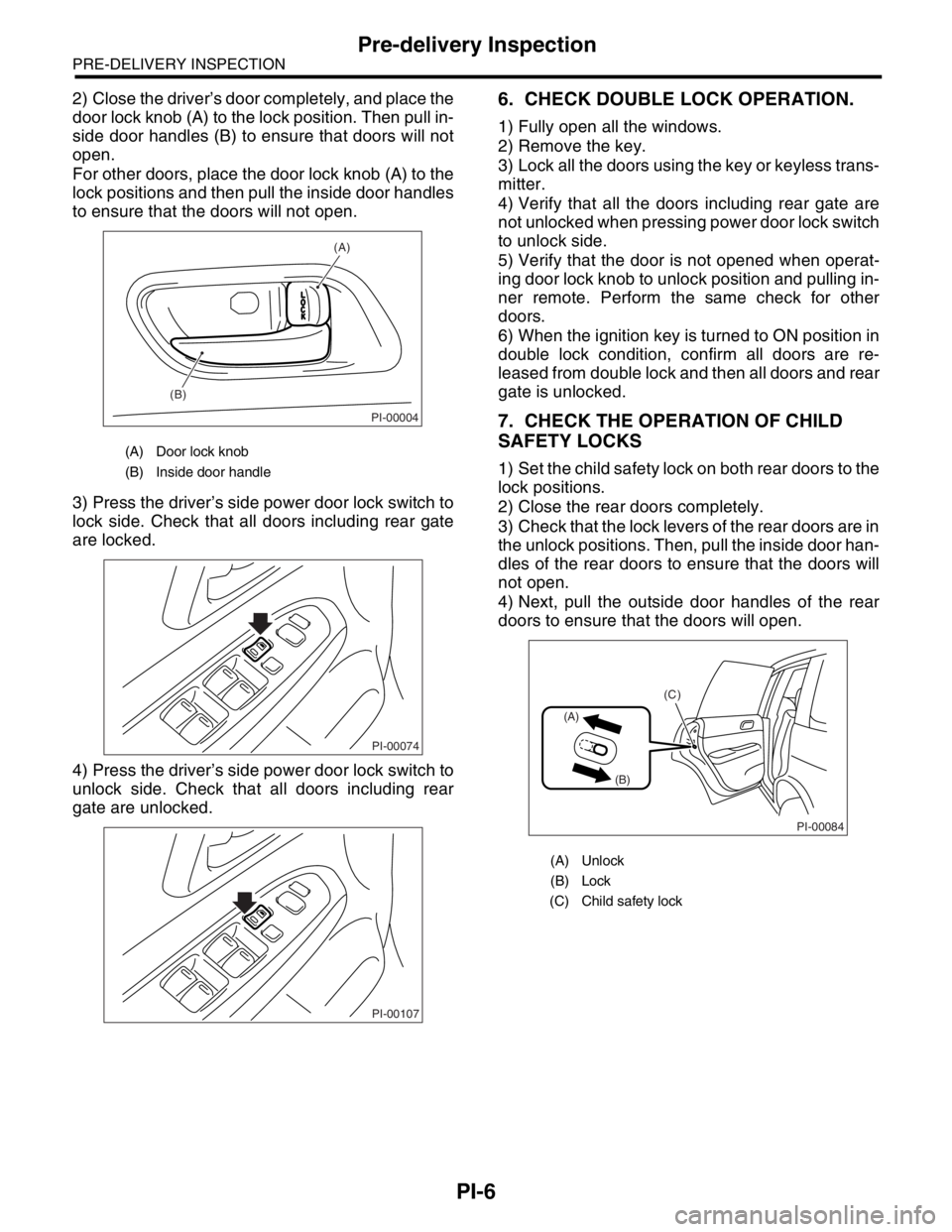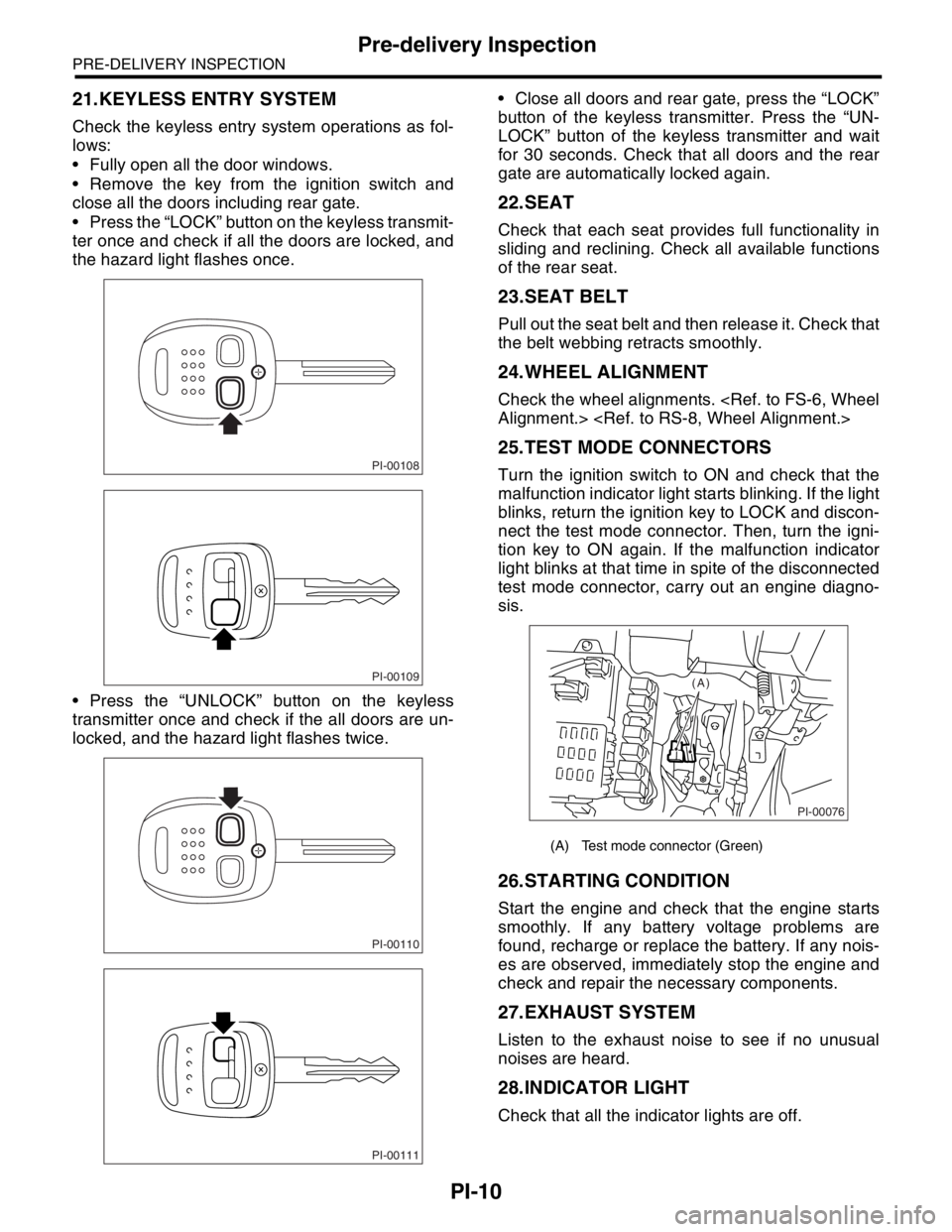2004 SUBARU FORESTER ignition
[x] Cancel search: ignitionPage 661 of 2870

IM-19
IMMOBILIZER (DIAGNOSTIC)
Diagnostics Procedure with Diagnostic Trouble Code (DTC)
C: DTC P1574 KEY COMMUNICATION FAILURE
DIAGNOSIS:
Failure of IMM ECM to verify key (transponder) ID code
Step Check Yes No
1 CHECK IMM ECM FUNCTION.
Insert the key to ignition switch (LOCK posi-
tion), measure changes in voltage between
Antenna connector.
Connector & terminal
(B142) No. 1 (+) — No. 2: (
−)Is the voltage −30 to 30 V?
(Approx. 0.1 second after
inserting the key)
Is the voltage 0 V?
(Approx. 1 second after insert-
ing the key)Go to step 2.Replace the IMM
ECM
Control Module.>
and then replace
all ignition keys
(including the tran-
sponder). Then
perform teaching
operation. Refer to
the teaching oper-
ation manual (Pub.
No. S0820GZ).
2 CHECK IGNITION KEY (TRANSPONDER).
1) Remove the key from ignition switch.
2) Start the engine using other keys that have
undergone the teaching operation, furnished
with vehicle.Does the engine start? Replace the igni-
tion key (including
the transponder).
Then perform
teaching opera-
tion. Refer to the
teaching opera-
tion manual (Pub.
No. S0820GZ).Replace the IMM
ECM
Control Module.>
and then replace
all ignition keys
(including the tran-
sponder). Then
perform teaching
operation. Refer to
the teaching oper-
ation manual (Pub.
No. S0820GZ).
Page 662 of 2870

IM-20
IMMOBILIZER (DIAGNOSTIC)
Diagnostics Procedure with Diagnostic Trouble Code (DTC)
D: DTC P0513 INCORRECT IMMOBILIZER KEY
DIAGNOSIS:
Use of unregistered key in IMM ECM
E: DTC P1576 EGI CONTROL MODULE EEPROM
DIAGNOSIS:
ECM malfunctioning
1. REPLACE ECM.
Replace the ECM.
Then perform teaching operation. Refer to the teaching operation manual (Pub. No. S0820GZ).
F: DTC P1577 IMM CONTROL MODULE EEPROM
DIAGNOSIS:
IMM ECM malfunctioning
1. REPLACE IMM ECM.
Replace the IMM ECM
cluding the transponder). Then perform teaching operation. Refer to the teaching operation manual (Pub.
No. S0820GZ).
Step Check Yes No
1 PERFORM TEACHING OPERATION ON IG-
NITION KEY.
Perform teaching operation on all keys of the
vehicle. Refer to the teaching operation man-
ual (Pub. No. S0820GZ).Is teaching operation for all
keys completed?END Replace all ignition
keys (including the
transponder). Go
to step 2.
2 PERFORM TEACHING OPERATION ON IG-
NITION KEY.
Perform teaching operation on all keys with
vehicle. Refer to the teaching operation man-
ual (Pub. No. S0820GZ).Is teaching operation for all
keys completed?END Replace the IMM
ECM
Control Module.>
and then replace
all ignition keys
(including the tran-
sponder). Then
perform teaching
operation. Refer to
the teaching oper-
ation manual (Pub.
No. S0820GZ).
Page 664 of 2870

IM-22
IMMOBILIZER (DIAGNOSTIC)
Diagnostics Procedure with Diagnostic Trouble Code (DTC)
Step Check Yes No
1 CHECK ANTENNA CIRCUIT.
1) Turn the ignition switch to OFF.
2) Disconnect the harness antenna connector
from IMM ECM.
3) Measure the resistance of antenna circuit.
Connector & terminal
(B142) No. 1 — No. 2:Is the resistance less than 10
Ω?Go to step 2.Replace the
antenna.
lizer Antenna.>
2 CHECK ANTENNA CIRCUIT.
Measure the resistance between antenna har-
ness connector and chassis ground.
Connector & terminal
(B142) No. 1 — Chassis ground:Is the resistance less than 10
Ω?Replace the
antenna.
lizer Antenna.>Go to step 3.
3 CHECK ANTENNA CIRCUIT.
Measure the resistance between antenna har-
ness connector and chassis ground.
Connector & terminal
(B142) No. 2 — Chassis ground:Is the resistance less than 10
Ω?Replace the
antenna.
lizer Antenna.>Go to step 4.
4 CHECK ANTENNA CIRCUIT.
1) Turn the ignition switch to ON. (engine
OFF.)
2) Measure the voltage between antenna har-
ness connector and chassis ground.
Connector & terminal
(B142) No. 1 (+) — Chassis ground(
−):Is the voltage 0 V? Go to step 5.Replace the
antenna.
lizer Antenna.>
5 CHECK ANTENNA CIRCUIT.
Measure the voltage between antenna har-
ness connector and chassis ground.
Connector & terminal
(B142) No. 2 (+) — Chassis ground(
−):Is the voltage 0 V? Go to step 6.Replace the
antenna.
lizer Antenna.>
6 CHECK IMM ECM FUNCTION.
1) Turn the ignition switch to OFF.
2) Connect the antenna harness connector to
IMM ECM.
3) Insert the key to ignition switch, measure
changes in voltage between antenna harness
connector.
Connector & terminal
(B142) No. 1 (+) — No. 2 (
−):Is the voltage −30 to 30 V?
(Approx. 0.1 second after
inserting the key)
Is the voltage 0 V?
(Approx. 1 second after insert-
ing the key)Go to step 7.Replace the IMM
ECM
Control Module.>
and then replace
all ignition keys
(including the tran-
sponder). Then
perform teaching
operation. Refer to
the teaching oper-
ation manual (Pub.
No. S0820GZ).
7 CHECK IGNITION KEY (TRANSPONDER).
1) Remove the key from ignition switch.
2) Start the engine using other keys that have
undergone the teaching operation, furnished
with vehicle.Does the engine start? Replace the igni-
tion key (including
the transponder).
Then perform
teaching opera-
tion. Refer to the
teaching opera-
tion manual (Pub.
No. S0820GZ).Replace the IMM
ECM
Control Module.>
and then replace
all ignition keys
(including the tran-
sponder). Then
perform teaching
operation. Refer to
the teaching oper-
ation manual (Pub.
No. S0820GZ).
Page 692 of 2870

SPC-3
SPECIFICATION
Forester
C: ELECTRICAL
★: For Australia model
D: TRANSMISSION
5MT: 5 forward speeds with synchromesh and 1-reverse
4AT: Electronically controlled fully-automatic, 4-forward speeds and 1-reverse
DSPD: Dry Single Plate Diaphragm
TCC: Torque Converter Clutch
★: For Europe model
E: STEERING
Model 2.0 L Non-turbo 2.0 L Turbo 2.5 L Non-turbo 2.5 L Turbo
Ignition timing at idling speed BTDC/rpm 10°±10°/650 12°±10°/700MT: 10°±10°/650
AT : 1 5°±10°/65017°±10°/700
Spark plug Type and manufacturerCHAMPION:
RC10YC4
NGK: PFR6GCHAMPION:
RC10YC4
NGK: ILFR6B
Alternate
NGK: BKR5E-11Alternate
NGK: BKR5E-11
Generator12 V — 90 A
Battery Type and capacity (5HR)MT: 12 V — 48 AH (55D23L)
AT: 12 V — 52 AH (65D23L)12 V — 27 AH
(34B19L)
12 V — 48 AH
(55D23L)
★
MT: 12 V — 48
AH (55D23L)
AT: 12 V — 52
AH (65D23L)
Model 2.0 L Non-turbo 2.0 L Turbo 2.5 L Non-turbo 2.5 L Turbo
Transmission type 5MT 4AT 5MT 4AT 5MT 4AT 5MT 4AT
Clutch type DSPD TCC DSPD TCC DSPD TCC DSPD TCC
Gear ratio1st 3.454 2.785 3.454 2.785 3.454 2.785 3.454 2.785
2nd 2.062 1.545 1.947 1.545 2.062 1.545 1.947 1.545
3rd 1.448 1.000 1.366 1.000 1.448 1.000 1.366 1.000
4th 1.088 0.694 0.972 0.694 1.088 0.694 0.972 0.694
5th 0.871 — 0.738 — 0.780 — 0.738 —
Reverse 3.333 2.272 3.333 2.272 3.333 2.272 3.333 2.272
Dual range 1.447 — — — 1.196 — — —
Reduction
gear (Front)1st reduc-
tionType of gear — Helical — Helical — Helical — Helical
Gear ratio — 1.000 — 1.000 — 1.000 — 1.000
Final reduc-
tionType of gear Hypoid
Gear ratio 4.111 4.444 4.444 4.111 4.111 4.444 4.111 4.444
Reduction
gear (Rear)Transfer
reductionType of gear Helical — Helical — Helical — Helical —
Gear ratio 1.000 —1.081
★,
1.000— 1.000 — 1.000 —
Final reduc-
tionType of gear Hypoid
Gear ratio 4.111 4.4444.111
★,
4.4444.111 4.111 4.444 4.111 4.444
Ty p eRack and Pinion, Integral
Turns, lock to lock3.0
Minimum turning circle m (ft)Curb to curb 10.6 (34.8)
Wall to wall 11.4 (37.4)
Page 701 of 2870

PC-2
PRECAUTION
Precaution
1. Precaution
A: PRECAUTION
Please clearly understand and adhere to the follow-
ing general precautions. They must be strictly fol-
lowed to avoid minor or serious injury to the person
doing the work or people in the area.
1. ABS
Handle the ABS as a total system. Do not disas-
semble or attempt to repair individual parts. Doing
so could prevent the ABS system from operating
when needed or cause it to operate incorrectly and
result in injury.
2. BRAKE FLUID
If brake fluid gets in your eyes or on your skin, do
the following:
Wash out your eyes and seek immediate medical
attention.
Wash your skin with soap and then rinse thor-
oughly with water.
3. RADIATOR FAN
The radiator fan may rotate without warning, even
when the engine is not on. Do not place your hand,
cloth, tools, or other items near the fan at any time.
4. ROAD TESTS
Always conduct road tests in accordance with traf-
fic rules and regulations to avoid bodily injury and
interrupting traffic.
5. AIRBAG
To prevent bodily injury from unexpected deploy-
ment of airbags and unnecessary maintenance, fol-
low the instructions in this manual when performing
maintenance on airbag components or nearby, and
airbag wiring harnesses or nearby.
To prevent unexpected deployment, perform the
steps below and then wait at least 20 seconds to
discharge electricity before beginning work.
Step 1: Turn the ignition switch OFF.
Step 2: Disconnect the ground cable from bat-
tery.
6. AIRBAG DISPOSAL
To prevent bodily injury from unexpected airbag
deployment, do not dispose airbag modules in the
same way as other refuse. Follow all government
regulations concerning disposal of refuse.
7. AIRBAG MODULE
Adhere to the following when handling and storing
the airbag module to prevent bodily injury from un-
expected deployment:
Do not hold the harnesses or connectors to carry
module.
Do not face the bag in the direction that it opens
towards yourself or other people.
Do not face the bag in the direction that it opens
towards the floor or walls.
8. AIRBAG SPECIAL TOOLS
To prevent unexpected deployment, only use spe-
cial tools.
9. WINDOW
Always wear safety glasses when working around
any glass to prevent glass fragments from damag-
ing your eyes.
10.WINDOW ADHESIVE
Always use the recommended or alternative adhe-
sive when attaching glass to prevent it from coming
loose and falling, resulting in accidents and injury.
Page 703 of 2870

NT-2
NOTE
Note
1. Note
A: NOTE
This is information that can improve efficiency of
maintenance and assure sound work.
1. FASTENER NOTICE
Fasteners are used to prevent parts from damage
and dislocation due to looseness. Fasteners must
be tightened to the specified torque.
Do not apply paint, lubricant, rust retardant, or oth-
er substances to the surface around bolts, fasten-
ers, etc. Doing so will make it difficult to obtain the
correct torque and result in looseness and other
problems.
2. STATIC ELECTRICITY DAMAGE
Do not touch the control unit, connectors, logic
boards, and other such parts when there is a risk of
static electricity. Always use a static electricity pre-
vention cord or touch grounded metal before con-
ducting work.
3. BATTERY
When removing the battery cables, always be sure
to turn the ignition switch off to prevent electrical
damage to the control unit from rush current.
4. SERVICE PARTS
Use authentic service parts for maximum perfor-
mance and maintenance, when conducting repairs.
Subaru/FHI will not be responsible for poor perfor-
mance resulting from the use of parts not specified
by a genuine dealer.
5. PROTECTING VEHICLE UNDER MAIN-
TENANCE
Make sure to attach the fender cover, seat covers,
etc. before work.
6. ENSURING SAFETY DURING WORK
When working in a group of two or more, perform
the work with calling each other to ensure mutual
safety.
Page 729 of 2870

PI-6
PRE-DELIVERY INSPECTION
Pre-delivery Inspection
2) Close the driver’s door completely, and place the
door lock knob (A) to the lock position. Then pull in-
side door handles (B) to ensure that doors will not
open.
For other doors, place the door lock knob (A) to the
lock positions and then pull the inside door handles
to ensure that the doors will not open.
3) Press the driver’s side power door lock switch to
lock side. Check that all doors including rear gate
are locked.
4) Press the driver’s side power door lock switch to
unlock side. Check that all doors including rear
gate are unlocked.6. CHECK DOUBLE LOCK OPERATION.
1) Fully open all the windows.
2) Remove the key.
3) Lock all the doors using the key or keyless trans-
mitter.
4) Verify that all the doors including rear gate are
not unlocked when pressing power door lock switch
to unlock side.
5) Verify that the door is not opened when operat-
ing door lock knob to unlock position and pulling in-
ner remote. Perform the same check for other
doors.
6) When the ignition key is turned to ON position in
double lock condition, confirm all doors are re-
leased from double lock and then all doors and rear
gate is unlocked.
7. CHECK THE OPERATION OF CHILD
SAFETY LOCKS
1) Set the child safety lock on both rear doors to the
lock positions.
2) Close the rear doors completely.
3) Check that the lock levers of the rear doors are in
the unlock positions. Then, pull the inside door han-
dles of the rear doors to ensure that the doors will
not open.
4) Next, pull the outside door handles of the rear
doors to ensure that the doors will open.
(A) Door lock knob
(B) Inside door handle
PI-00004
(A)
(B)
PI-00074
PI-00107
(A) Unlock
(B) Lock
(C) Child safety lock
PI-00084
(A)
(B)
(C)
Page 733 of 2870

PI-10
PRE-DELIVERY INSPECTION
Pre-delivery Inspection
21.KEYLESS ENTRY SYSTEM
Check the keyless entry system operations as fol-
lows:
Fully open all the door windows.
Remove the key from the ignition switch and
close all the doors including rear gate.
Press the “LOCK” button on the keyless transmit-
ter once and check if all the doors are locked, and
the hazard light flashes once.
Press the “UNLOCK” button on the keyless
transmitter once and check if the all doors are un-
locked, and the hazard light flashes twice. Close all doors and rear gate, press the “LOCK”
button of the keyless transmitter. Press the “UN-
LOCK” button of the keyless transmitter and wait
for 30 seconds. Check that all doors and the rear
gate are automatically locked again.
22.SEAT
Check that each seat provides full functionality in
sliding and reclining. Check all available functions
of the rear seat.
23.SEAT BELT
Pull out the seat belt and then release it. Check that
the belt webbing retracts smoothly.
24.WHEEL ALIGNMENT
Check the wheel alignments.
25.TEST MODE CONNECTORS
Turn the ignition switch to ON and check that the
malfunction indicator light starts blinking. If the light
blinks, return the ignition key to LOCK and discon-
nect the test mode connector. Then, turn the igni-
tion key to ON again. If the malfunction indicator
light blinks at that time in spite of the disconnected
test mode connector, carry out an engine diagno-
sis.
26.STARTING CONDITION
Start the engine and check that the engine starts
smoothly. If any battery voltage problems are
found, recharge or replace the battery. If any nois-
es are observed, immediately stop the engine and
check and repair the necessary components.
27.EXHAUST SYSTEM
Listen to the exhaust noise to see if no unusual
noises are heard.
28.INDICATOR LIGHT
Check that all the indicator lights are off.
PI-00108
PI-00109
PI-00110
PI-00111
(A) Test mode connector (Green)
PI-00076
(A)